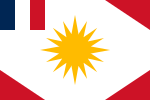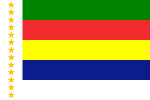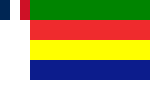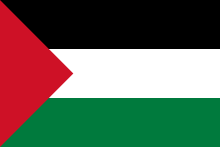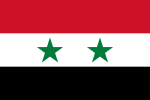Flag of Syria
| Flag of the Syrian Arab Republic | |
|---|---|
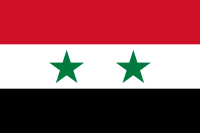 |
|
| Vexillological symbol : |
|
| Aspect ratio: | 2: 3 |
| Officially accepted: | first adopted again in 1958 on March 30, 1980 |
The current flag of Syria has been used by the Syrian Arab Republic since 1980. The same flag was used by Syria as a member of the United Arab Republic from 1958 to 1961 and its meaning goes back to the Arab liberation flag .
Appearance and meaning

The colors used red, white, black and green are pan-Arabic colors , which are assigned the following meanings:
- Red represents the blood that was shed in order to achieve the goals in battle
- White symbolizes the bright future
- Black represents the years of oppression
- Green is the color of the Prophet Mohammed and Islam
The two stars originally symbolized the states of Egypt and Syria as members of the United Arab Republic.
Historical flags of Syria
Before 1918, the territory of Syria was part of the Ottoman Empire and used its flag . After the Ottoman Empire was defeated in World War I , an Arab administration was established in Syria with British help , which existed between 1918 and 1920. The Arab administration used the flag of the Arab Revolution as the flag of Syria, from which the Pan-Arab colors come. It shows a black, green and white horizontal stripe, into which a red triangle protrudes.
A seven-pointed white star was added to the flag between March 8 and July 24, 1920, the brief period of the unrecognized kingdom of Syria under King Faisal I by the victorious powers .
French mandate
In September 1919, the British had handed control of Lebanon and Syria to France . On April 25, 1920, Syria became a French mandate . King Faisal I was overthrown on July 24, 1920.
A flag with a white crescent moon on a light blue background and the French flag in the upper left corner may have been introduced for the mandate area between July and August 1920 . The mandate area was divided into five states: The Sanjaks of Damascus , Aleppo and Latakia ( Alevi state ) and the mandate areas of the Jebel ad-Duruz and Greater Lebanon . Each state received its own flag, each with the French flag in the upper left corner.
- The flag of Aleppo showed three golden, five-pointed stars offset to the right in a triangle on a white background. It was in use from 1920 to 1925.
- The Damascus flag was a white disk on a navy blue background. It was in use from 1920 to 1922.
- Latakia had a golden, 16-pointed sun on a white background and three red corners in its flag. It was in use from 1920 to 1936. Flag variants with eleven or 20 sun rays are also reported.
- In the state flag of the Jebel ad-Duruz area, the left and lower sides were covered by a white, L-shaped stripe. The rest of the flag consisted of four horizontal stripes of green, red, yellow, and blue. From 1921 to 1924 it did not contain the French flag, but rather 13 yellow, five-pointed stars in the left, white stripe. In 1924 the stars disappeared and the French tricolor was used. The flag was in use until 1936. The civil flag consisted of only five horizontal stripes in the same colors. Red stands for the heart and love, green for the farmers and life, yellow for the sun and the wheat, blue for the sky and destiny and white for the purity and the air.
- The flag of Greater Lebanon differs from the other flags in design. Instead of in the top corner, the French flag formed the basis of the flag. In the white stripe, the flag showed the cedar , which is later found in the flag of independent Lebanon . It was designed by Naoum Mukarzel , President of the Lebanese Resistance Movement.
In June 1922, a loose Syrian Federation excluding Lebanon was created out of the four other states. This federation used three horizontal green, white and green stripes on its flag with the French flag in the upper left corner. When Aleppo and Damascus were united to form the Syrian state on December 1, 1924, they continued to use the green-white-green flag. The other parts of Syria were annexed in 1937. There are different reports of variants of the flag.
 ? Flag of the French Mandate of Syria
? Flag of the French Mandate of Syria
 ? Flag of the State of Aleppo 1920–1925
? Flag of the State of Aleppo 1920–1925
 ? Flag of the State of Damascus
? Flag of the State of Damascus
 ? Flag of the State of Latakia 1920–1936
? Flag of the State of Latakia 1920–1936
 ? ? Civil flag of the mandate area of Jebel ad-Duruz 1921–1936
? ? Civil flag of the mandate area of Jebel ad-Duruz 1921–1936

 ? State flag of the mandate area of Jebel ad-Duruz 1921–1924
? State flag of the mandate area of Jebel ad-Duruz 1921–1924
 ? State flag of the mandate area of Jebel ad-Duruz 1924–1936
? State flag of the mandate area of Jebel ad-Duruz 1924–1936
 ? Flag of Greater Lebanon 1920–1943
? Flag of Greater Lebanon 1920–1943
 ? Syrian Federation 1922 to 1925
? Syrian Federation 1922 to 1925
Syrian State 1925 to 1932.
Independent Syria and the Arab Federations

Syria was granted autonomy in 1932 . As the national flag, it adopted a flag with three horizontal stripes green-white-black and three pentagonal, red stars in the white stripe. The stars stood for the three districts of Syria, Aleppo, Damascus and Deir ez-Zor . She was first hoisted on January 1, 1932 in Aleppo and on June 11 in Damascus. In 1936 Latakia and the Jebel ad-Duruz area were added to the republic. The stars now stood for Aleppo together with Damascus and Deir ez-Zor , the Jebel ad-Duruz area and the third for Latakia. Syria finally gained its independence in 1946 and initially retained the flag.
From 1958 to 1961 Syria was part of the United Arab Republic along with Egypt . The republic used a flag with three horizontal stripes red, white and black and two pentagonal green stars in the white stripe. The stars stood for Syria and Egypt. It corresponds to today's flag.
Syria left the Union on September 28, 1961 and re-adopted its old flag from 1932.
After the coup d'état by the Ba'ath Party in 1963, a red, white and black flag with three green stars was used. It should symbolize the planned federation with Egypt and Iraq . The Iraq used this flag in different variations by 2008.
From January 1, 1972, with the formation of the Federation of Arab Republics of Egypt, Libya and Syria, a common red-black-white flag was used, which shows the golden falcon of the Quraysh in the white band , which is a band with the name of the federation. Egypt and Libya also had the country name below the banner. Syria kept this flag beyond the end of the Federation of Arab Republics in 1977 until 1980. After the failure of another Syrian-Iraqi union project in 1979 and instead of a return to the three-star VAR flag from 1963, Syria decided in 1980 to adopt the two-star VAR flag from To be used again in 1958. Egypt kept the Federation flag until 1984.
1: 2 ? Flag of the Syrian Republic 1932–1958

2: 3 ? Flag of the United Arab Republic 1958–1972, from 1961 only the flag of Egypt

1: 2 ? Flag of Syria 1961–1963

1: 2 ? Flag of Syria 1963-1972

2: 3 ? Flag of Syria at the time of the Federation of Arab Republics

Old flag in the civil war from 2011
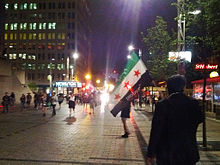
With the start of the Syrian civil war in 2011 against the rule of the Assad family and the Ba'ath party, some insurgent groups used the old green, white and black national flag, which was in use before the Ba'ath party came to power, instead of the current national flag. Similarly, the protest movement in Libya had used the flag as a symbol before the regime came to power and reintroduced it as the national flag after its victory. In Syria, too, the old national flag has become a symbol of the opposition. The Free Syrian Army uses their color combination in its badge, as does the national coalition .
In Syria itself, the Islamist al-Nusra front has its own black flag with Shahada instead of the old flag . The Islamic State movement in Iraq and Syria , which fights against both the government and the opposition coalition and once controlled other parts of Syria , also flies its own black flag.
2: 3 ? Variant 1 of the old flag used by rebels in the Civil War

2: 3 ? Variant 2 of the old flag used by rebels in the Civil War

More flags of Syria
On the flag of Damascus Province ( Madinat Dimaschq ) is the great mosque of Damascus and the inscription Dimashq el-Asad (Damascus, the lion).
The Ba'ath Party uses a flag with three horizontal stripes black, white and green and a red triangle. It corresponds to the flag of the Iraqi Ba'ath Party and the flag of Palestine .
The flag of the Aramaeans ( Christian Syrians ) minority shows a winged, golden altar on a red background.
Assyrian Christians live in Syria, as well as in Iran , Iraq and Lebanon . The Assyrian flag was designed by the Assyrian Universal Alliance in 1968. It has its origins in the representation of the Assyrian sun god Šamaš on which the sun disk stands on an altar. The golden circle in the middle represents the sun, which generates heat and light with its flames in order to sustain the living beings of the earth. The star that surrounds the sun symbolizes the land, the light blue color symbolizes serenity. The undulating stripes represent the three main rivers of the Assyrian homeland: the Tigris, the Euphrates and the great Zab . The dark blue stripes represent the Euphrates, whose Assyrian name means “Abundance”. The red stripes stand for courage, glory and pride, they represent the Tigris. The white lines between these two great rivers represent the great Zab, the white color symbolizes peace. Some interpret the red, white and blue stripes as the paths that will lead the scattered Assyrians back to their ancestral homeland. The god of the Assyrians "Assur" from pre-Christian times can be seen above the Assyrian flag.
The small Turkmen minorities , mainly in Aleppo, Damascus and Latakia, use a red flag with a Turkish crescent and a five-pointed star modeled on the flag of Turkey . On the upper edge there are also two thin stripes, blue and white, on the lower edge two more in white and green.
The flag of the Assyrians ( Suryoye, Suroye / Suraye )
Web links
- History of the Syrian flag (english)
swell
- Flags of the World - Syria (English)
Individual evidence
- ↑ Gaddafi's death spurs opposition in Syria , Reuters Germany of October 21, 2011
- ↑ Official website of the Free Syrian Army ( Memento of the original from January 29, 2012 in the Internet Archive ) Info: The archive link was automatically inserted and has not yet been checked. Please check the original and archive link according to the instructions and then remove this notice.
- ^ Spiegel Online
- ^ Flags of the World - Assyria
- ↑ Millibayraq




